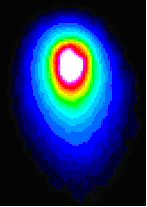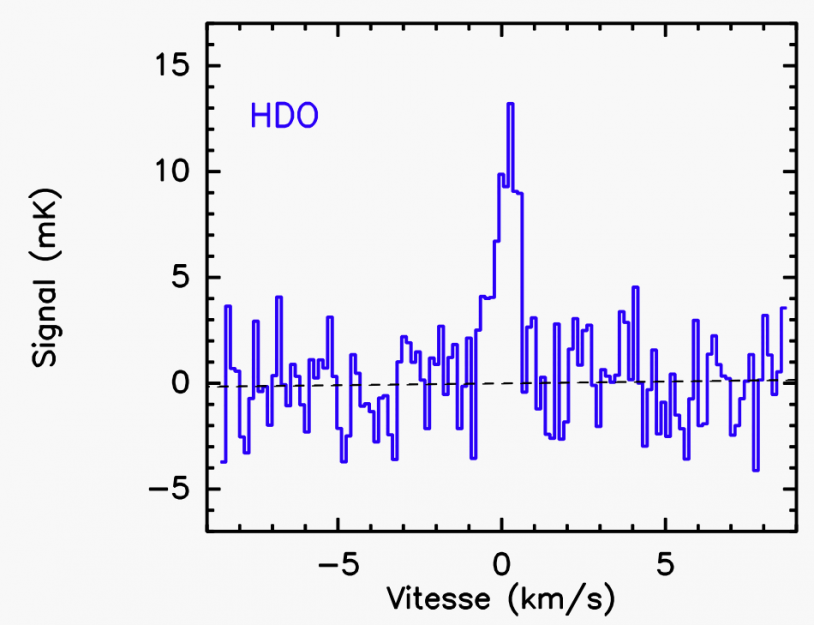An international team, including four investigators of the Observatory of Paris and the CNRS, just discovered the first comet - 103P/Hartley 2 - which hosts Earth's ocean-like water. The announcement was made online on www.nature.com on October 5th, 2011 and published on October 13th in the Nature magazine.

Oceans cover two thirds of the Earth, but where does the water come from? The question has been in all scientists' minds for decades. Now they almost all agree on a extraterrestrial origin of water. Here is their scenario: at the origin, the Earth was hot and dry until water molecules were brought during a bombardment of celestial bodies. Just need to find which ones: meteorites? asteroids? comets?
That is what the debate hinges upon. This debate is enriched by the last observations of the Hartley 2 comet, obtained by the ESA's HERSCHEL infrared space telescope. This result comes from a study performed on sub-millimetre wavelengths, unobservable from the ground.
A good tool for physicochemical diagnostic is the relative ratio between the abundances of two molecules: H2O standard water (two hydrogen atoms hydrogen and one oxygen atom) and HDO heavy water in which a deuterium (twice as heavy) atom takes over a hydrogen atom.
In the oceans, the deuterium/hydrogen ratio (D/H) is about 0.0156 %. This figure is similar to the one found in meteorites coming from the asteroid belt between Mars and Jupiter.
Within the six yet studied comets, including the famous Halley and Hale-Bopp, the ratio appeared to be twice as high as the one on Earth.
This result seemed likely to identify asteroid as the main source of Earth's water. The comets would not have contributed more than 10%.
Comets have returned to the foreground

Nevertheless, the new study is more in favour of comets: they would in fact have contributed to the terrestrial water. The scientists detected HDO heavy water (specific form of H2O water) for the first time in a comet coming from the Kuiper belt: a vast reservoir of iced objects which spreads at great distance from the Sun, beyond Neptune.
Since its discovery in 1986, Hartley 2 could be re-observed four times. Its last incursion was in 2010. On October 20th, it passed close to the Earth at 16 million kilometres. The Herschel telescope could thus observe it on November 17th using the Heterodyne Instrument for the Far Infrared (HIFI). Those observations were performed within the frame of the international campaign for the Hartley 2 comet monitoring in October and November 2010. In this context the NASA's Deep Impact/EPOXI probe also flew by the moon on November 4th.
The measured deuterium/hydrogen ratio was 0.016 %. An ocean-like value. This unforeseen result likely reflected the specific origins of the Hartley 2 comet which is now coming back close to the Sun every six years: very probably coming from the Kuiper belt, beyond Neptune, it might have been ejected a few tens or hundreds of thousands years ago. That would explain its specific structure.
On their sides, the six previously studied comets would have formed near giant planets of the solar system. Their affected orbits then brought them into the Oort cloud, at several tens of thousands times the Earth-Sun distance, i.e. several hundreds of thousands kilometres from the Sun.
The reservoir of small bodies with Earth-like water proved to be, in the final event, bigger than expected: it spreads much beyond the asteroid belt (between Mars and Jupiter) and could even reach the Kuiper cometary belt, beyond Neptune. The oceans' water could have been brought on Earth by a rain of cosmic icebergs.
Article references
Ocean-like water in the Jupiter-family comet 103P/Hartley 2, Paul Hartogh1, Dariusz C. Lis2, Dominique Bockelée-Morvan3, Miguel de Val-Borro1, Nicolas Biver3, Michael Küppers4, Martin Emprechtinger2, Edwin A. Bergin5, Jacques Crovisier3, Miriam Rengel1, Raphael Moreno3, Slawomira Szutowicz6, Geoffrey A. Blake2, Science, october 2011.
1 Max-Planck-Institut für Sonnensystemforschung, Max-Planck-Str. 2, 37191 Katlenburg-Lindau, Germany
2 California Institute of Technology, Pasadena, California 91125, USA
3 LESIA (Observatory of Paris, CNRS, Université Pierre et Marie Curie, Université Paris Diderot), Meudon, France
4 Rosetta Science Operations Centre, European Space Astronomy Centre, 28691 Villanueva de la Cañada, Madrid, Spain
5 Astronomy Department, University of Michigan, Ann Arbor, Michigan 48109, USA
6 Space Research Centre, Polish Academy of Sciences, 00-716 Warsaw, Poland
Contacts
- Scientific contacts: Dominique Bockelée-Morvan, Nicolas Biver, Jacques Crovisier ou Raphael Moreno
- Solar system program scientist at CNES: Francis Rocard